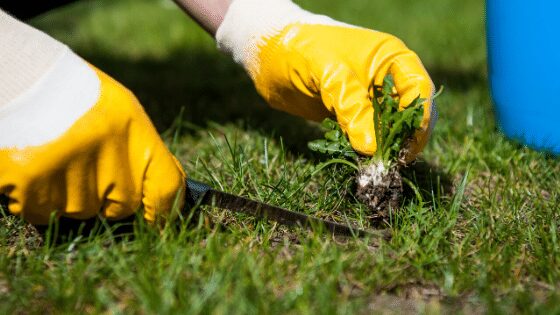You wouldn’t think spring is around the corner from the looks of it, but before you know it, warmer temps will have arrived, and your lawn will bounce back. Here are some lawn care tips you can start doing soon to prep for a beautiful and healthy lawn.
Lawn Care Tips
There are several things you can do soon to prepare your lawn for summer heat and rains. They include:
- Raking
- Overseeding
- Aerating
- Dethatching
- Weeding
- Fertilizing
- Watering
- Mowing
Let’s discuss some of these early spring chores and the best times to do them.
Prepping Your Lawn for Spring
Spring raking has advantages to help get your lawn in tip-top shape for the upcoming summer. Remove any leaves that dropped before the snow-covered them, as well as any blades of grass that died during winter. Left alone, the dead blades contribute to your lawn’s thatch (a loose, intermingled organic layer of dead and living shoots, stems, and roots, which develops between the zone of green vegetation and the soil surface).
Raking also loosens any matted grass clumps from snow mold, which can suffocate new growth. Pick a spring-tine rake that has a strong upward pull to remove dead grass. Wait until the soil isn’t soft or muddy, or you may pull up healthy grass crowns.
Here are the rest of lawn care tips for a lush, green lawn this summer.
Overseed
This late-spring chore helps fill bare or thin spots in the lawn for warm-season grass, with fall being the best time for cool-season grass. In colder regions like Utah, spot seeding small areas in early spring give good results. Apply a slow-release nitrogen fertilizer when you overseed. Five weeks later, apply a quick-release nitrogen feed.
Aerate
For a healthy lawn, it’s best to aerate your lawn, depending on your soil type and how you use your lawn. Generally, late spring to early summer is good for warm-season grasses. Fall is best for cool-season grasses. If you didn’t get to it last fall, you could aerate in early spring.
Dethatch
Spring is the ideal time to dethatch turf. Try for early spring for cool-season grasses and late spring to early summer for warm-season grasses.
Weed
Crabgrass is common in Utah, so applying a pre-emergent herbicide helps to keep seeds that dropped last year from germinating. Note that timing is crucial for using this application. Follow product instructions to learn about timing and dosing.
Fertilize
Three weeks after grass starts greening, apply fertilizer. This is typically after about two or three mowings. Don’t use too early or you risk feeding weeds and creating fertilizer runoff. Also, it can trigger lush blade growth at the wrong time, when roots aren’t ready to begin their spring growth spurt.
Water
This is tricky since many cities in Utah and elsewhere have scheduled times when they turn on irrigation water. Once it gets warmer and the water is on, keep an eye on the weather. Spring usually results in more rain, so ensure you follow weather conditions. Getting a smart meter allows you to schedule waterings because they can learn about your area and determine how much water you need and when.
Contact Monarch Sod for Spring Installation
If you’ve just moved into a new home or office building without a lawn, contact us for information on when we deliver and install sod in the spring.











